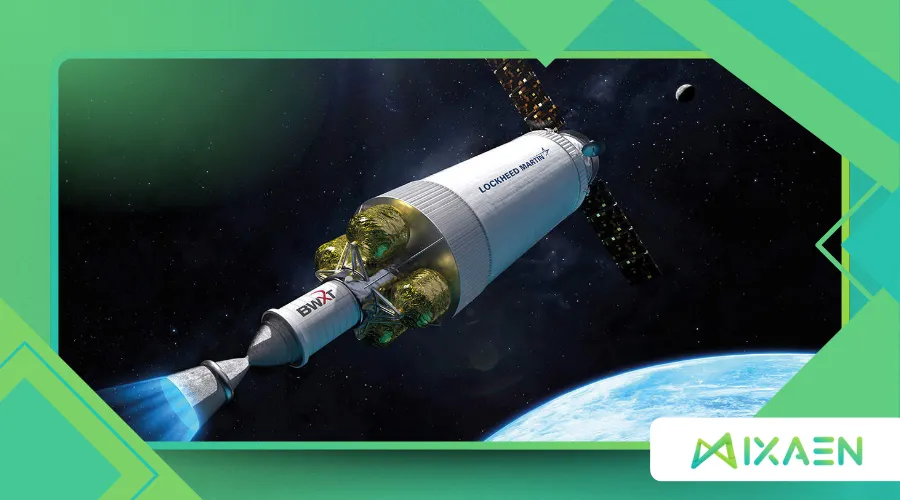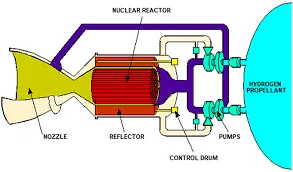Nuclear Propulsion: Accelerating Deep Space Travel

Nuclear propulsion stands at the forefront of humanity’s quest to conquer the vastness of space, promising to redefine the boundaries of exploration.
Anúncios
Imagine a spacecraft slicing through the cosmos at speeds that make today’s chemical rockets seem like horse-drawn carriages—an analogy that captures the transformative potential of this technology.
Unlike traditional propulsion systems, which rely on burning chemical fuels, nuclear propulsion harnesses the immense energy locked within atomic nuclei to propel spacecraft faster and farther.
This leap could shrink travel times to Mars, unlock distant worlds, and make deep space missions more feasible than ever.
But what exactly makes this technology a game-changer, and why should we care now?
The Urgency of Advanced Propulsion Systems
The urgency to develop advanced propulsion systems stems from the limitations of chemical rockets.
These workhorses of space exploration, while reliable, are inefficient for long-distance missions.
They require massive amounts of fuel, which increases spacecraft weight and cost.
A trip to Mars using chemical propulsion takes about seven months, a duration that strains resources, crew health, and mission budgets.
Nuclear propulsion, by contrast, offers a way to dramatically reduce transit times while carrying more payload.
The technology isn’t science fiction—it’s grounded in decades of research and recent breakthroughs that signal a new era of space travel.
Additionally, as the global interest in Mars missions intensifies, the need for faster and more efficient travel becomes paramount.
Investments in nuclear propulsion could lead to significant advancements, allowing us to explore not only Mars but also the outer planets and beyond.
The Science Behind Nuclear Propulsion
At its core, nuclear propulsion taps into the energy released from nuclear reactions—either fission or, in more speculative designs, fusion.
Nuclear thermal propulsion (NTP) heats a propellant, like hydrogen, using a nuclear reactor, expelling it at high speeds to generate thrust.
Nuclear electric propulsion (NEP), on the other hand, uses nuclear energy to power electric thrusters, offering steady, efficient acceleration over long periods.
Both approaches yield far greater efficiency than chemical rockets, measured by specific impulse—a metric of how effectively a rocket uses propellant.
For context, chemical rockets have a specific impulse of around 450 seconds, while NTP systems can exceed 900 seconds, effectively doubling efficiency.
Consider a mission to Jupiter’s moon Europa, a prime target for astrobiology.
With chemical propulsion, the journey takes over six years, as seen in NASA’s Galileo mission.
An NTP-powered spacecraft could cut this to under three years, preserving crew health and reducing exposure to cosmic radiation.
This efficiency stems from the immense energy density of nuclear fuel.
A single ton of uranium can release energy equivalent to millions of tons of chemical propellant, making it ideal for deep space missions where every kilogram counts.
Moreover, ongoing research into advanced materials and reactor designs could further enhance the performance and safety of nuclear propulsion systems.
+ What If the Apollo Missions Happened with Today’s Technology?
Why Nuclear Propulsion Matters Now
The renewed focus on nuclear propulsion isn’t just theoretical—it’s driven by tangible progress.
In 2023, NASA and DARPA announced the DRACO (Demonstration Rocket for Agile Cislunar Operations) program, aiming to test a nuclear thermal propulsion system in orbit by 2027.
This milestone could pave the way for crewed Mars missions by the 2030s.
The statistic is striking: a 2021 study by the National Academies of Sciences estimated that NTP could reduce Mars transit times by up to 25%, saving months of travel and billions in mission costs.
This urgency reflects a broader shift in space exploration.
Private companies like SpaceX are pushing the boundaries of chemical rockets, but even their Starship, a marvel of engineering, can’t match the efficiency of nuclear systems for deep space.
Governments and agencies are racing to secure a foothold in cislunar space and beyond, with China and Russia also investing in nuclear propulsion research.
The question isn’t whether nuclear propulsion will shape the future—it’s who will master it first.
For more insights into the advancements in nuclear propulsion, visit NASA’s official page.

Benefits and Challenges in a High-Stakes Race
The advantages of nuclear propulsion extend beyond speed.
By reducing travel time, it mitigates the physical and psychological toll on astronauts.
Shorter missions mean less exposure to microgravity, which weakens bones and muscles, and lower radiation doses from cosmic rays.
Additionally, nuclear systems can carry heavier payloads, enabling more ambitious missions—like establishing a permanent lunar base or sending rovers to the outer planets.
Yet, the path forward isn’t without hurdles.
Safety concerns loom large, as launching nuclear reactors into space raises fears of accidents or radioactive contamination.
While modern designs incorporate robust safeguards, public perception remains a challenge.
Cost is another factor; developing and testing nuclear propulsion systems demands significant investment.
For example, the DRACO program’s budget is estimated at $1 billion, a fraction of what chemical rocket programs consume but still substantial.
Regulatory frameworks also lag behind, complicating international collaboration.
++ Building the First Space Elevator: Challenges and Breakthroughs
Innovative Applications: Two Original Examples
To grasp the potential of nuclear propulsion, consider two hypothetical missions.
First, the Aurora Probe, a nuclear electric propulsion spacecraft designed to explore the Kuiper Belt.
Unlike chemical rockets, which struggle to reach these distant regions, the Aurora could maintain steady thrust for years, mapping dozens of icy bodies in a single mission.
Its nuclear reactor would power ion thrusters, sipping propellant while accelerating to speeds unattainable by conventional means.
This could unlock new insights into the solar system’s origins, revealing secrets hidden in the Kuiper Belt’s ancient objects.
Second, imagine the Odyssey Lander, a crewed mission to Saturn’s moon Titan.
Using nuclear thermal propulsion, the lander could reach Titan in under two years, compared to seven with chemical rockets.
Its reactor would heat hydrogen propellant, delivering the thrust needed to carry a habitat module for surface exploration.
Titan’s lakes of methane and potential for prebiotic chemistry make it a prime target, and nuclear propulsion could make such a mission feasible within our lifetime.
These missions not only demonstrate the potential of nuclear propulsion but also highlight the urgent need for continued investment in this technology.

Addressing the Skeptics
Critics argue that nuclear propulsion is too risky or costly compared to proven chemical systems.
But is clinging to outdated technology the answer when the cosmos beckons?
The risks—while real—are manageable with modern engineering.
For instance, reactors can be launched in a dormant state, activated only in orbit to minimize terrestrial hazards.
Cost concerns, too, must be weighed against long-term savings.
A single nuclear-powered mission could replace multiple chemical ones, delivering more science for the dollar.
Environmental concerns also arise, particularly about radioactive waste in space.
However, nuclear propulsion systems are designed to contain byproducts, and their fuel use is minimal compared to terrestrial reactors.
The trade-off is clear: a small, controlled risk for a giant leap in exploration capability.
Ignoring this potential could leave humanity tethered to the inner solar system, unable to reach the stars.
The Road Ahead: A New Space Age
Looking forward, nuclear propulsion could redefine space exploration’s timeline.
By the 2040s, we might see crewed missions to the asteroid belt or robotic probes to the Oort Cloud, regions once deemed unreachable.
The technology also aligns with humanity’s broader ambitions, from mining asteroids to establishing off-world colonies.
Each step forward builds on the last, creating a feedback loop of innovation.
The global race for nuclear propulsion underscores its strategic importance.
China’s plans for a nuclear-powered shuttle by 2040 and Russia’s megawatt-class nuclear space tug highlight the competitive landscape.
The U.S., with its DRACO program, aims to stay ahead, but collaboration could accelerate progress.
International partnerships, like those that built the International Space Station, could pool resources and expertise, ensuring nuclear propulsion benefits all of humanity.
Engaging the Future
The promise of nuclear propulsion lies not just in technology but in what it enables—a future where humanity is no longer confined to Earth’s backyard.
It’s a tool to answer questions about our place in the universe, from the habitability of Mars to the mysteries of distant exoplanets.
The 2021 National Academies study underscores its potential, projecting that nuclear propulsion could enable a Mars sample return mission by 2035, a critical step toward understanding the Red Planet’s history.
As we stand on the cusp of this revolution, the question looms: will we seize this opportunity to redefine exploration, or remain bound by the limits of yesterday’s technology?
Nuclear propulsion isn’t just about speed—it’s about ambition, about daring to dream of a universe within reach.
By embracing it, we can accelerate not just spacecraft but humanity’s journey into the cosmos.
